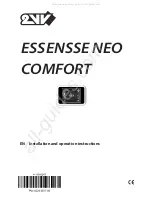
CHAPTER 5: SETTINGS
PRODUCT SETUP
L90 LINE CURRENT DIFFERENTIAL SYSTEM – INSTRUCTION MANUAL
5-115
5
The EnerVista software is required to view all captured data. The relay faceplate display can be used to view the date and
time of trigger, the fault type, the distance location of the fault, and the reclose shot number.
The
FAULT REPORT 1 SOURCE
setting selects the source for input currents and voltages and disturbance detection. For dual-
breaker applications where the line current is supplied individually from two breaker CTs, the fault locator source should
include the sum of currents from both CTs as well as the line voltage. For the application of entirely parallel lines, the fault
report can be programmed to apply compensation for the zero sequence mutual coupling between parallel lines when
calculating fault resistance and fault loop impedance. If this compensation is required, the ground current (3I_0) from the
parallel line must be connected to the ground input CT of the CT bank configured under the
FAULT REPORT 1 SOURCE
with
the same polarity as the phase current input configured in the same source.
The
FAULT 1 REPORT TRIG
setting assigns the FlexLogic operand representing the protection element/elements requiring
operational fault location calculations. The distance to fault calculations are initiated by this signal. The
FAULT REPORT 1 Z1
MAG
,
FAULT REPORT 1 Z0 MAG
, and
FAULT REPORT 1 Z0M MAG
impedances are entered in secondary ohms.
For a two-terminal line application, the
FAULT REPORT 1 Z1 MAG
,
FAULT REPORT 1 Z1 ANG
,
FAULT REPORT 1 Z0 MAG
,
FAULT
REPORT 1 Z0 ANG
and
FAULT REPORT 1 LENGTH
settings for the entire line must to be entered for fault location calculations.
For the application of entirely parallel lines, Z0M MAG/ANG is the mutual zero-sequence impedance for the whole line,
required to compensate the calculation of fault resistance and fault loop impedance. For a three-terminal application,
these settings are used to enter the line segment impedance and length from the local terminal to the tap point only. The
figure shows the supported configurations of parallel lines in three-terminal applications.
Figure 5-49: Supported configurations of parallel lines in three-terminal applications
The
FAULT REP 1 REM1-TAP Z1 MAG
and
FAULT REP 1 REM1-TAP Z1 ANG
settings are used for three-terminal applications to
enter positive sequence section impedances (in secondary ohms) for the line segment from remote terminal 1 to the tap
point. The length of the line section from remote terminal 1 to the tap point is entered in the
FAULT REP 1 REM1-TAP LENGTH
setting.
The
FAULT REP 1 REM2-TAP Z1 MAG
,
FAULT REP 1 REM2-TAP Z1 ANG
, and
FAULT REP 1 REM2-TAP LENGTH
settings are used as
above, but for the line segment from remote terminal 2 to the tap point.
The
FAULT REPORT 1 VT SUBSTITUTION
setting is set to “None” if the relay is fed from wye-connected VTs. If delta-connected
VTs are used, and the relay is supplied with the neutral (3V0) voltage, this setting is set to “V0”. The method is still exact, as
the fault locator combines the line-to-line voltage measurements with the neutral voltage measurement to re-create the
line-to-ground voltages. See the
ACTUAL VALUES
RECORDS
FAULT REPORTS
menu for details. It is required to configure
the delta and neutral voltages under the source indicated as input for the fault report. Also, the relay checks if the auxiliary
signal configured is marked as “Vn” by the user (under VT setup) and inhibits the fault location if the auxiliary signal is
labeled differently.
















































